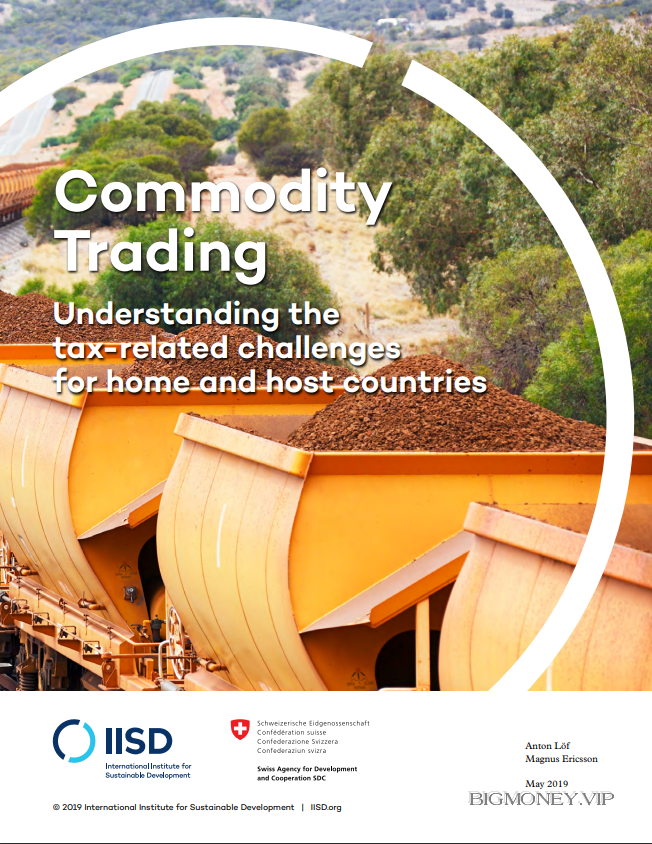Commodity Trading Understanding the tax-related challenges for home and host countries

1.0 Introduction
No other subject within the scope of international political economy can approach
the importance of trade in its effect on the lives of people as both producers and
consumers; and yet no other subject has been so neglected in serious academic writing.
—Cheryl Payer (1975, p. vii)
Some 40 years after Payer wrote this about commodity trading, Longchamp and Perrot added that
“academic research on commodity trading is scarce. ... Not only is scientific analysis lacking, but that
basic, independent data on commodity trading is missing” (2017, p. 10). The interviews performed for
this study confirmed that the commodity trading sector is largely secretive and unknown. There is little
research available on trading companies, especially in the mineral and metal sectors—a situation that
largely persists. Without solid basic facts about number of companies, traded commodities and revenues,
it is difficult to arrive at more than a preliminary understanding and rough estimate of tax risks and how
to address them for either host countries (where the mines are located) or home countries (where the
trading company is incorporated or has a tax base).
1.1 Scope of the Study
The scope of the study narrows the field of potential commodity trading companies to those dealing with
non-fuel minerals (all minerals and metals excluding fuel minerals, i.e., hydrocarbon oil/gas and coal) but
not agricultural commodities. Commodity trading companies dealing only in agricultural commodities
and oil and gas are thus excluded. Most of the major commodity trading companies are trading in both
oil and gas and minerals and metals. The primary focus of this study is on their activities in minerals and
metals. Sale of mineral and metal products by privately held mining companies to independent trading
companies and the tax risks created in such trade form the narrow focus set by the terms of reference.
Transfer pricing in trade between related parties is hence not covered in this study.
During our work, we have noticed that the activities carried out by mineral and metal trading companies
and their role in global mineral and metal markets are generally not well known. The report hence starts
by setting out in some detail the environment within which the trading companies work and what tools
they use. The report discusses the roles and functions of mineral and metal trading companies and the
business models they apply. Particular focus is put on the financing and operational activities of these
companies. The present development trends within the sector, both in geographical terms and changes
to the business model, are further explored. This sets a proper basis for how to understand both the
potential positive impacts on a country’s economic and social development options and potential tax
risks associated with mining and commodity trading. The general starting point in this study is that it
should be possible to deal with the negatives so often associated with mining—be they environmental
degradation, macro-economic problems or tax avoidance—and that mining, as an important lever for
social and economic development, is possible and feasible for many mineral-rich countries.
It is outside
the scope of the study to go into details of possible new tax systems to deal with the tax risks identified.
We have, however, identified some areas that need further study by tax specialists.
The study does not presuppose any in-depth knowledge of the global mining industry and trade. Those
who already know the mining sector can turn directly to Section 3, An Introduction to Commodity
Trading, without reading the Background section, which presents some key facts about world mining
relevant to the understanding of commodity trading and mineral and metal trading companies.
1.2 Method
The research has been divided into two stages. First, an initial phase of literature review was followed
by the scope of work agreed upon with the International Institute of Sustainable Development. Next, a
second phase of semi-structured interviews followed with persons with experience in metal trading. Over
50 interviews were conducted with persons from 24 countries. It has not been possible to gather much
quantitative data, neither from the interviews nor from other publicly available sources. Many trading
companies are privately held and, even if listed, they severely limit access to data and information. The
interviews were made anonymously and with the proviso that no details of any specific companies
or interviewees were to be identifiable. It was necessary for us to agree to such conditions to be able
to undertake almost all of the interviews. The interviews were used as the most important source of
information in writing this report.
1.3 Structure of the Report
The report starts with an introduction to the global mining industry: the size of production and exports
in value and volume terms; the geographical location of mining; the most important minerals and metals;
and the contribution of mining to national economies. Additional details on iron ore and gold industries
are given as examples of the economically most important metals. In the following sections, we define
central concepts such as primary commodity and commodity trading company. A brief description of the
commodity exchanges and an introduction to various ways of trading in minerals and metals, including
various financial instruments, show the environment in which trading companies are active. Details of
price setting, contracts and the role of currencies in metal trading supplement the picture.
The report goes on to describe in some detail the roles, functions and business models applied by metal
and mineral trading companies. We put a particular focus on the financing and operational activities of
mineral and metal trading companies. We discuss present development trends within the sector both in
geographical terms and changes to the business model.
The report concludes with a discussion of the potential tax risks related to the business model of
commodity trading companies. The effects on government revenue collection are presented. Finally, a
number of actions possible to combat these risks for both home and host countries are outlined and
discussed.
Commodity Trading Understanding the tax-related challenges for home and host countries




